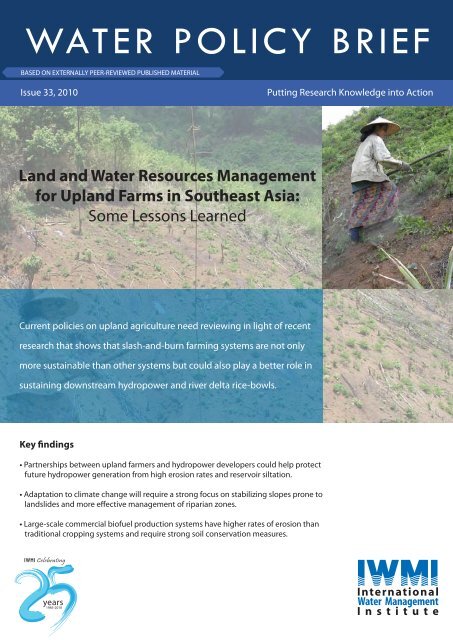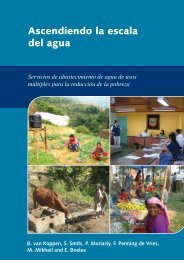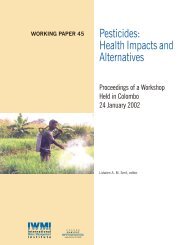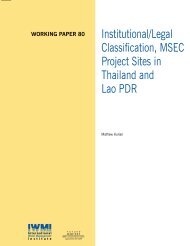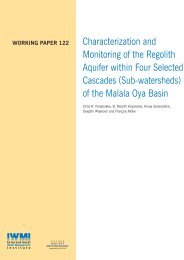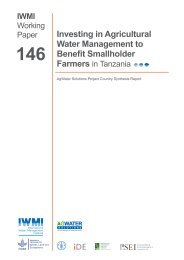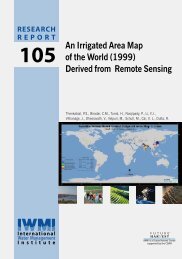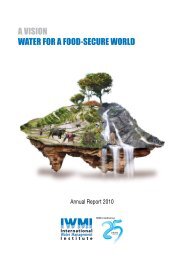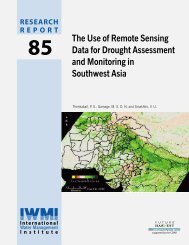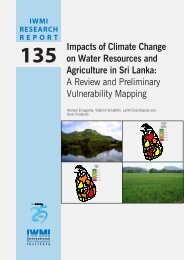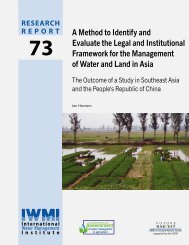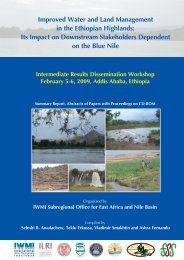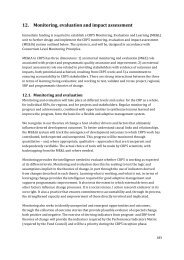Land and water resources management for upland farms
Land and water resources management for upland farms
Land and water resources management for upland farms
You also want an ePaper? Increase the reach of your titles
YUMPU automatically turns print PDFs into web optimized ePapers that Google loves.
WATER POLICY BRIEF<br />
BASED ON EXTERNALLY PEER-REVIEWED PUBLISHED MATERIAL<br />
Issue 33, 2010<br />
Putting Research Knowledge into Action<br />
<strong>L<strong>and</strong></strong> <strong>and</strong> Water Resources Management<br />
<strong>for</strong> Upl<strong>and</strong> Farms in Southeast Asia:<br />
Some Lessons Learned<br />
Current policies on upl<strong>and</strong> agriculture need reviewing in light of recent<br />
research that shows that slash-<strong>and</strong>-burn farming systems are not only<br />
more sustainable than other systems but could also play a better role in<br />
sustaining downstream hydropower <strong>and</strong> river delta rice-bowls.<br />
Key findings<br />
• Partnerships between upl<strong>and</strong> farmers <strong>and</strong> hydropower developers could help protect<br />
future hydropower generation from high erosion rates <strong>and</strong> reservoir siltation.<br />
• Adaptation to climate change will require a strong focus on stabilizing slopes prone to<br />
l<strong>and</strong>slides <strong>and</strong> more effective <strong>management</strong> of riparian zones.<br />
• Large-scale commercial biofuel production systems have higher rates of erosion than<br />
traditional cropping systems <strong>and</strong> require strong soil conservation measures.<br />
IWMI Celebrating<br />
years<br />
1985-2010
how l<strong>and</strong> use change related to a range of farming<br />
systems affects soil erosion <strong>and</strong> the hydrological<br />
response of <strong>water</strong>sheds. In total, 27 upl<strong>and</strong> catchments<br />
were analyzed.<br />
What the research tells us<br />
Annual rates of sediment generation under normal<br />
rainfall <strong>and</strong> traditional slash-<strong>and</strong>-burn systems are, on<br />
average, less than one tonne per hectare a year, which is<br />
well within natural rates of soil regeneration.<br />
The Nam Ngum hydropower facility in Lao PDR that provides energy <strong>for</strong><br />
domestic <strong>and</strong> international markets. Accelerated siltation of hydropower<br />
dams has significant economic, environmental <strong>and</strong> social implications.<br />
Upl<strong>and</strong> agriculture<br />
De<strong>for</strong>estation <strong>and</strong> inappropriate agricultural practices<br />
have damaged 2 billion hectares of the world’s arable<br />
l<strong>and</strong>. In spite of global improvements in the<br />
<strong>management</strong> of l<strong>and</strong> <strong>resources</strong>, unsustainable l<strong>and</strong> use<br />
practices result in net losses of cropl<strong>and</strong> productivity<br />
estimated to average 0.2%/year. Given the extent of the<br />
damage already done, it is imperative that we increase<br />
the productivity of arable l<strong>and</strong> in a manner that can<br />
sustain both food security <strong>and</strong> ecosystem services.<br />
Photo credit: Andrew Noble<br />
Converting l<strong>and</strong> from traditional slash-<strong>and</strong>-burn<br />
production systems to commercial cash crops such as<br />
maize, cassava or tree plantations, particularly non-native<br />
species such as rubber, can result in substantial increases<br />
in sediment yields (>6-13 t ha-1 yr -1 ) that exceeds the<br />
tolerable rate of soil loss of about 2.5 t ha -1 yr -1 .<br />
Extreme rainfall events, such as typhoons, have a<br />
significant impact on soil erosion which can exceed the<br />
impact of changes in cropping systems. A single event in<br />
Vietnam in July 2003 accounted <strong>for</strong> 42% of the total<br />
sediment yield that year.<br />
Water yields in the dry season are highly responsive to<br />
changes in l<strong>and</strong> use. As <strong>water</strong>sheds are returned to the<br />
fallow phase in a slash-<strong>and</strong>-burn farming cycle, the<br />
baseflow in streams in the dry season is significantly<br />
reduced, resulting in lower <strong>water</strong> yields to downstream<br />
users. In other words, more <strong>for</strong>est in the <strong>water</strong>shed<br />
translates into less <strong>water</strong> <strong>and</strong> not more.<br />
Changes in l<strong>and</strong> allocation, settlement policies <strong>and</strong><br />
property rights can significantly, <strong>and</strong> not always<br />
positively, affect soil degradation.<br />
In Southeast Asia, an estimated 50 million upl<strong>and</strong><br />
farmers practice slash-<strong>and</strong>-burn or ‘swidden’ agriculture.<br />
This traditional farming practice of shifting cultivation<br />
involves clearing <strong>and</strong> burning <strong>for</strong>est plots <strong>for</strong> cultivation<br />
of subsistence crops such as upl<strong>and</strong> rice. These plots are<br />
cultivated <strong>for</strong> one to three seasons <strong>and</strong> left fallow <strong>for</strong><br />
between 6 to 15 times the cropping period.<br />
When upl<strong>and</strong>s are cleared of <strong>for</strong>ests <strong>and</strong> farmed using<br />
unsustainable methods, the soil loses nutrients <strong>and</strong> the<br />
soil structure can be permanently damaged. As the l<strong>and</strong><br />
becomes less productive, crop yields fall <strong>and</strong> lead to<br />
increased competition <strong>for</strong> dwindling <strong>resources</strong>. Without<br />
appropriate interventions, the soil washes away when it<br />
rains <strong>and</strong> the l<strong>and</strong> becomes unusable. The continued<br />
rapid clearance of upl<strong>and</strong> vegetation <strong>for</strong> agriculture is<br />
likely to reduce rain<strong>water</strong> infiltration, resulting in the<br />
higher occurrence of floods <strong>and</strong> droughts <strong>and</strong>,<br />
eventually, crop failures. Climate change may well<br />
amplify the problem.<br />
Long-term studies were undertaken by the French<br />
Institute of Research <strong>for</strong> Development (IRD), International<br />
Water Management Institute (IWMI) <strong>and</strong> their national<br />
partners in several small <strong>water</strong>sheds in Lao PDR,<br />
Thail<strong>and</strong>, Vietnam, Philippines <strong>and</strong> Indonesia, to quantify<br />
Soil washed away from degraded upl<strong>and</strong>s silts up rivers <strong>and</strong> <strong>water</strong> bodies<br />
downstream. Implementing sustainable l<strong>and</strong>-use practices can reduce<br />
such negative impacts.<br />
Photo credit: Christian Valentin<br />
2
Photo credit: Christian Valentin<br />
The cultivation of slopes using traditional implements results in a significant movement of soil down the slope contributing to the<br />
entire erosion process.<br />
Implications <strong>for</strong> policymakers<br />
Slash-<strong>and</strong>-burn farming systems can be sustainable.<br />
Rates of sediment generation under slash-<strong>and</strong>-burn<br />
systems are well within the bounds of natural<br />
replacement. As long as the fallow phase on the rotation<br />
is long enough (8-15 years), <strong>and</strong> the cropping phase is<br />
short (1-3 seasons), these systems can rejuvenate <strong>and</strong><br />
remain highly productive. A key to sustaining slash-<strong>and</strong>burn<br />
systems is the relative low population density of<br />
most upl<strong>and</strong> areas. Depopulation of upl<strong>and</strong>s associated<br />
with urbanization <strong>and</strong> out-migration <strong>for</strong> off-farm<br />
opportunities will help traditional slash-<strong>and</strong>-burn<br />
systems to remain sustainable. For these reasons, a<br />
review of current policies encouraging the eradication of<br />
slash-<strong>and</strong>-burn farming systems is warranted.<br />
Promotion of commercial cash cropping systems <strong>for</strong><br />
maize, jatropha, cassava <strong>and</strong> perennial tree-based<br />
plantations such as teak <strong>and</strong> rubber should be tied to<br />
appropriate conservation methods that minimize<br />
sediment generation. Many simple, inexpensive<br />
methods are readily available. However, conservation<br />
policies using these technologies <strong>and</strong> approaches need<br />
to be <strong>for</strong>mulated <strong>and</strong> en<strong>for</strong>ced. These may include<br />
incentive-based mechanisms such as payments <strong>for</strong><br />
environmental services (PES) or a National Soil<br />
Conservation Act en<strong>for</strong>ceable through a legal<br />
framework <strong>and</strong> institutions (e.g., conservation <strong>and</strong><br />
extension services). This becomes even more critical in<br />
the context of climate change, when severe extreme<br />
events are predicted.<br />
Watersheds respond rapidly to changes in l<strong>and</strong> use.<br />
Revegetation of catchments either naturally or through<br />
plantations will result in declining dry season <strong>water</strong><br />
yields. This has significant implications <strong>for</strong> people in<br />
communities <strong>and</strong> industries who depend on these flows.<br />
Ideally, provisions will be made to ensure the supply of<br />
<strong>water</strong> in light of l<strong>and</strong> uses in upper catchments. Such<br />
provision might include small <strong>water</strong> storage <strong>and</strong> supply<br />
infrastructures as well as l<strong>and</strong> uses that are diversified to<br />
match upl<strong>and</strong> l<strong>and</strong>scapes. As l<strong>and</strong>-use changes are often<br />
initiated by changes in property rights or market<br />
incentives, such instruments will require an ex-ante<br />
impact assessment be<strong>for</strong>e being implemented.<br />
Concluding observations<br />
Results from this long-term study have significant<br />
implications in view of the different regional <strong>and</strong> global<br />
stress factors <strong>and</strong> drivers affecting agricultural<br />
production. For example, the current regional emphasis<br />
on hydropower generation could be undermined by high<br />
erosion rates <strong>and</strong> reservoir siltation. Hydropower<br />
developers could protect their investments through<br />
partnerships with upl<strong>and</strong> communities that offer<br />
economic incentives <strong>for</strong> the use of conservation<br />
agricultural practices in upl<strong>and</strong> <strong>water</strong>sheds.<br />
The increasing probability of extreme rainfall events -<br />
predicted to come with climate change - would<br />
drastically increase erosion rates. Preventative, ‘no regrets’<br />
approaches include a strong focus on stabilizing slopes<br />
prone to l<strong>and</strong>slides <strong>and</strong> more effective <strong>management</strong> of<br />
riparian zones.<br />
Changes in traditional l<strong>and</strong>-use, in particular the shift to<br />
large-scale commercial biofuel production will require<br />
increased soil conservation measures as these systems<br />
showed much higher rates of erosion than traditional<br />
cropping systems.<br />
Erosion should be seen as a natural process which<br />
requires balancing <strong>management</strong> interventions with both<br />
the positive <strong>and</strong> negative impacts associated with<br />
sediment generation. For instance, in view of the world<br />
food crisis <strong>and</strong> the role that Asian deltas play in global<br />
rice supply, sediment-rich flood<strong>water</strong> constitutes a<br />
natural fertilizing system <strong>and</strong> must be maintained.<br />
This implies a basin approach <strong>for</strong> any social cost-benefit<br />
analysis to consider the impacts of upstream<br />
interventions on all types of downstream communities<br />
<strong>and</strong> <strong>water</strong> uses.<br />
In order to achieve sustainable development <strong>and</strong><br />
<strong>management</strong> of l<strong>and</strong> <strong>resources</strong> that deliver the desired<br />
outcomes of enhance productivity, improved livelihoods<br />
<strong>and</strong> the provision of ecosystem services, an integrated<br />
approach to l<strong>and</strong>-use <strong>management</strong> <strong>and</strong> planning is<br />
required. The development of a <strong>management</strong> plan that<br />
considers the social <strong>and</strong> economic needs of communities<br />
living in both the upper <strong>water</strong>sheds <strong>and</strong> the lower river<br />
basins is a prerequisite.<br />
3
Source<br />
This issue of Water Policy Brief is based on research conducted by the Institut de Recherche pour le Développement (IRD);<br />
International Water Management Institute (IWMI); Indonesian Centre <strong>for</strong> Agricultural <strong>L<strong>and</strong></strong> Resources Research <strong>and</strong><br />
Development (ICALRRD), Bogor, Indonesia; Agricultural Engineering Programme, School of Mechanical Engineering, Fiji<br />
Institute of Technology, Suva, Fiji; National Park, Wildlife <strong>and</strong> Plant Conservation Department (NPWPCD), Bangkok,<br />
Thail<strong>and</strong>; Philippine Council <strong>for</strong> Agriculture, Forestry <strong>and</strong> Natural Resources Research <strong>and</strong> Development (PCARRD), Los<br />
Baños, Philippines; Soil <strong>and</strong> Fertiliser Institute (SFRI), Hanoi, Vietnam; <strong>and</strong> National Agriculture <strong>and</strong> Forestry Research<br />
Institute (NAFRI), Vientiane, Lao PDR.<br />
The content is, in particular, based on the following externally peer-reviewed publications:<br />
Valentin, C.; Agus, F.; Alamban, R.; Boosaner, A.; Bricquet, J. P.; Chaplot, V.; de Guzman, T.; de Rouw, A.; Janeau, J. L.; Orange,<br />
D.; Phachomphonh, K.; Do Duy Phai; Podwojewski, P.; Ribolzi, O.; Silvera, N.; Subagyono, K.; Thiébaux, J. P.; Tran Duc Toan;<br />
Vadari, T. 2008. Runoff <strong>and</strong> sediment losses from 27 upl<strong>and</strong> catchments in Southeast Asia: Impact of rapid l<strong>and</strong> use changes<br />
<strong>and</strong> conservation practices. Agriculture, Ecosystems <strong>and</strong> Environment 128: 225–238.<br />
Clement, F.; Orange, D.; Williams, M.; Mulley, C.; Epprecht, M. 2009. Drivers of af<strong>for</strong>estation in Northern Vietnam: Assessing<br />
local variations using geographically weighted regression. Applied Geography 29(4): 561-576.<br />
Other Related IWMI Publications<br />
Open access (electronic version freely accessible via the internet)<br />
Clement, F. 2006. Underst<strong>and</strong>ing farmers’ strategies <strong>and</strong> l<strong>and</strong> use change in the northern upl<strong>and</strong>s of Vietnam. Water Figures<br />
Asia: news of IWMI's work in Asia, 1:4-5.<br />
Clément, F.; Amezaga, J.; Orange, D.; Toan, Tran Duc. 2007. The impact of government policies on l<strong>and</strong> use in Northern<br />
Vietnam: an institutional approach <strong>for</strong> underst<strong>and</strong>ing farmer decisions. Colombo, Sri Lanka: International Water Management<br />
Institute (IWMI). 21p. (IWMI Research Report 112). doi: 10.3910/2009.112<br />
Kurian, M. 2004. Institutions <strong>for</strong> integrated <strong>water</strong> <strong>resources</strong> <strong>management</strong> in upl<strong>and</strong> <strong>water</strong>sheds of Southeast Asia:<br />
A comparative analysis of Thail<strong>and</strong> <strong>and</strong> Lao PDR. Colombo, Sri Lanka: International Water Management Institute (IWMI). 25p.<br />
(IWMI Working Paper 081). doi: 10.3910/2009.253<br />
Orange, D.; Podwojewski, P.; Toan, Tran Duc; Van Rinh, Pham; Phai, Do Duy; Phuong, Nguten Duy. 2007. Impact of l<strong>and</strong>-use<br />
on bed load transported by rivers in the Dong Cao Watershed, North Vietnam. Water Figures Asia: news of IWMI’s work in Asia,<br />
1: 4-5.<br />
Citation:<br />
International Water Management Institute (IWMI). 2010. <strong>L<strong>and</strong></strong> <strong>and</strong> <strong>water</strong> <strong>resources</strong> <strong>management</strong> <strong>for</strong> upl<strong>and</strong> <strong>farms</strong> in Southeast Asia: some<br />
lessons learned. Colombo, Sri Lanka: International Water Management Institute (IWMI). 4p. (IWMI Water Policy Brief 33)<br />
doi:10.3910/2010.200<br />
Keywords: Water resource <strong>management</strong> / highl<strong>and</strong>s / shifting cultivation / soil degradation / cropping systems / South East Asia<br />
Copyright © 2010, by IWMI. All rights reserved. IWMI encourages the use of its material provided that the organization is<br />
acknowledged <strong>and</strong> kept in<strong>for</strong>med in all such instances.<br />
Credits<br />
Editing: Mahen Ch<strong>and</strong>rasoma / Design <strong>and</strong> Layout: Manoj Jayasuriya<br />
Water Policy Briefs are published by IWMI several times each year to highlight new <strong>and</strong> practical approaches to <strong>water</strong> <strong>and</strong> l<strong>and</strong> <strong>resources</strong><br />
<strong>management</strong> professionals.<br />
Briefs are available online free of charge at www.iwmi.org/Publications/Water_Policy_Briefs/index.aspx<br />
Comments <strong>and</strong> questions are welcome. Please contact us at:<br />
Publications Unit<br />
International Water Management Institute<br />
PO Box 2075, Colombo<br />
Sri Lanka<br />
Tel: +94 11 288 0000<br />
Fax: +94 11 278 6854<br />
E-mail: <strong>water</strong>policybriefing@cgiar.org<br />
www.iwmi.org


